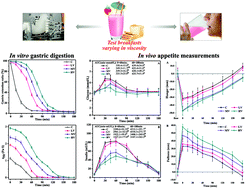In vitro gastric emptying characteristics of konjac glucomannan with different viscosity and its effects on appetite regulation†
Abstract
Konjac glucomannan (KGM) is associated with the satiety-enhancing property by imparting the food matrix with high viscosity. In the present study, rheology tests on KGM sol with different viscosities were conducted to understand its flow behavior as they presented in the mouth and stomach, and the in vitro gastric emptying characteristics of KGM were examined with a human gastric simulator. Then, their effects on subjective appetite, glycemia, and appetite-related hormones (insulin, GLP-1, PYY3-36, CCK-8, ghrelin) response were investigated by conducting a randomized, single-blind, crossover trial in 22 healthy adults (11 female and 11 male, mean age (years): 23.2 ± 2.0, BMI (kg m−2): 20.6 ± 2.1). The blood samples and ratings for subjective appetite were collected at regular time intervals after the subjects were fed with four test breakfasts (one control treatment and three experimental treatments) on four different days. An ad libitum lunch was provided to the subjects once they consumed the breakfasts and their food intake was recorded. As the viscosity increased, the gastric emptying rate was delayed despite a large part of the chyme viscosity lost during digestion. The satiating capacity of the test breakfast was significantly enhanced as its viscosity increased, the and subjects’ sensation for hunger, fullness, desire-to-eat, and prospective food consumption differed significantly (p = 0.006, 0.000, 0.002, and 0.001, respectively) between the treatments. The secretion of glycemia and satiety-related hormones were beneficially modulated by the increased viscosity of the test meal but a small decrease in the ad libitum food intake was observed after the intervention of the viscous test breakfasts. Overall, elevating the meal viscosity moderately by using KGM could contribute to combating the challenge of hunger for people in the bodyweight management.



 Please wait while we load your content...
Please wait while we load your content...